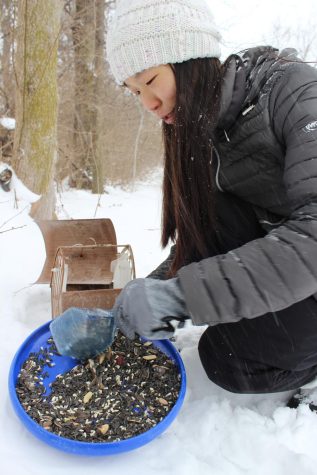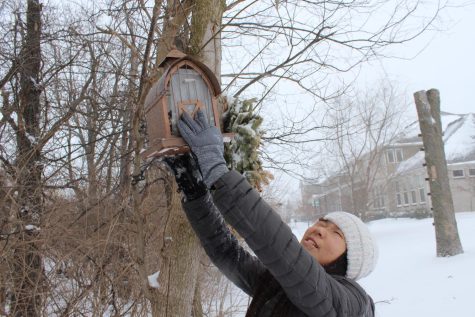Nicole Oehler, program coordinator at Wild Birds Unlimited

What time of the year should people pay attention to bird-feeding?
You can feed birds all year long; they are always in survival mode, because no matter what time of year it is, they have different caloric needs. For instance, this time of year, they need a lot more calories and fat and protein because of the cold weather. They burn more energy and birds don’t eat at night, so they’ve got to make it through those long cold winter nights, sometimes several hours before they eat again. And birds, in order to survive the winter, they have a very high metabolism which means they burn a lot of calories to stay warm and to generate heat. Over the course of a long night, during really cold weather, they can burn about half of their body fat. So this is an important time of year to feed.
But then, when we get into spring time and birds are beginning to get ready for nesting season, those females, for instance, they’re going to start producing eggs and need additional calories and also calcium to be able to do that. And once the young hatch, of course, then they’ve got the added burden of providing extra food for their young but also maintaining their own body conditions.
How should new bird-feeders start out?
(The) best thing to do if you haven’t fed the birds before is you’re (going to want to) figure out, first of all, what types of birds are in your yard, what types of birds you might be able to attract and what type of food they might be interested in eating. So we recommend that you start by offering some…samples of each kind of food. And a great way to do that is something that we carry called a “Flying Start Combo”, and it is a very simple basic bird-feeder and it comes with three different types of …bird-food cylinders…and you get a suet (cylinder) and birds who like suet are birds who would naturally eat insects, so they like higher fat and protein, like woodpeckers, nut hatchers, wrens, chickadees, birds like that. It also comes with a (cylinder) called “Nutty for Nuts;” it’s a cylinder of all just nuts, so again, it’s extra fat and proteins that a lot of birds really like. And then there is a third one called “No mess” and it is a cylinder that has seeds in it, so it has pea shells, sunflower seeds and peanuts in it as well as some fruit, so that covers the feed-eating birds as well. And so, what you do is put that out, put all (cylinders) together, see what birds come to it and see if you can tell if they like something else more or less than something else.
Is bird food carried by stores the best option for feeding the birds?
What we carry (at Wild Birds Unlimited is) blended bird food that is appropriate for the birds that are in our area, and they don’t have any fillers in them. Sometimes you see if you go to some hardware stores and places like that with bird-seed, you’ll notice that it sometimes is a lot cheaper. But you have to be careful because the way they make it a lot cheaper is by adding things birds cannot eat, and that can be anything from adding seeds that are not desirable to sticks. So our seed is clean, and it’s also really fresh, which is important. We get our seed in weekly here. Just like us, birds don’t want to eat old food, and bird feed, of course, can go bad over time, and (birds will not eat them and it is also not good for them). I do know some people who make their own suet, which you can do it’s really kind of a process and most people don’t want to go through the trouble. So it’s a lot to just buy it pre-made.
What should new bird-feeders keep in mind?
I would say that the biggest thing that we see, not as a mistake, but just that we see people not doing, is not cleaning the bird-feeders often enough. If you’re going to feed the birds, the best thing you can do for them is to make sure that their food is clean and the feeders are the same. Of course, they sometimes go to the bathroom in the same place where they eat, so making sure that stuff is cleaned up and making sure that the seed has not gone moldy from getting wet, I would say, is probably the most important thing.
Aiyana Gifford, childhood bird-watching enthusiast and junior
What got you into bird-watching when you were younger?
To be honest, I just thought birds were really pretty and I wanted to catch them on camera, and I thought it was a cool talent to be able to identify birds when I was younger because I was a weird kid.
Were there any resources that you used to help you with building your bird-watching abilities?
I would always check out books on birds and those bird-watcher manuals so that I could look for defining features. I just enjoyed learning about birds for the most part, but I would also try to find the more interesting and identifiable birds, although, where we live, there is not much bird diversity, or at least I felt like I didn’t get to see the birds I really wanted to see, like a peacock or something.
What was your favorite part about bird-watching?
My favorite part was probably attempting to draw the birds that I actually did recognize, like house sparrows which were pretty common, but I also really liked their coat of feathers, so I liked drawing them.
Arthur Yeh, bird-watching learner and junior
How did you get into bird-watching?
I first met (this man) when I was biking. I saw this guy in this get-up with, like, khakis on and a cool hat, and he had this nice camera that he was taking pictures on. So I went up and I asked him what exactly he was doing, and he told me that he was bird-watching. I asked him a little bit about the identifiers for certain birds, and he showed me pictures of the birds he had taken pictures of. I honestly don’t even really remember his name, but I thought the pictures of the birds that he took in flight were so cool, so I did a little bit of my own research at home.
Did that lead you to take up bird-watching?
Yeah, because I also wanted to be able to find cool birds, identify them and take like in-flight moving pictures. In Indiana, you might not think that you see as many birds, but personally, I think birds like hawks can look really majestic, and I often tried to take pictures of the hawk in motion, but it was usually too far off to come out the way I wanted it to.
Were there any other birds that you really enjoyed looking for?
Yeah, my thing was mostly like the big birds, though. So I liked looking for the bald eagles and the hawks, mostly. But I would also try and identify the different masses of birds that flew in that V-shape towards the south whenever winter came up.
Logan Obrique, sophomore and bird-watching enthusiast since eighth grade
What about bird watching made it so interesting for you?
Well, I had a lot of interests that I wanted to explore, and when I was in eighth grade we had this bird-watching unit in the last quarter while we were in COVID-19. Since I had so much free time, I thought that I might as well expand a lot into bird-watching. I would read a bunch of bird articles and basically try to gather as much information as possible so that I could recognize actual birds.
Did you note down your bird-watching experiences in any way?
I really liked to draw birds. I would capture as many pictures as possible of all the birds I could identify, then I would compare the pictures, or at least the close-enough ones, to the bird that I thought it looked like. I would then draw the bird, and kind of keep a journal of the various birds I had seen.
How is bird-watching beneficial?
Well, honestly just to feel more connected with nature and take some time to admire it. I feel like we are so stuck in our own lives, and being given this ability to explore something like bird-watching really led me down a rabbit-hole of actually appreciating information instead of just studying it.

Cecilia “CeCe” Pike, sophomore and amateur birdwatcher
What did you enjoy the most about birdwatching?
I really enjoyed being able to just look at a bunch of birds with different coats of feathers, and categorize them. (Categorizing) was fun because there were so many different intricacies to focus on with birds. So many birds looked so alike, and there were these basic defining characteristics that determined which bird they were exactly.
Were you able to easily differentiate between birds?
I wouldn’t say it was ever easy to differentiate between birds because even within the same species they can be so diverse.
Was there any information that allowed greater ease in differentiating between birds?
Yeah, I mean there were so many online sources that told you exactly what the differences in birds looked like, especially between, like, similar-looking birds, but also they were helpful in understanding all the characteristics that birds of one species could have.
Melinda Yong, sophomore and bird-watching enthusiast
Why was bird-watching so interesting to you?
My dad was into bird-watching and I always thought it was interesting, so being able to share that in common with him definitely made us closer. So I think bird-watching is a hobby that can bring people together.
Were there any specific birds that you were easily able to identify?
I was able to identify the sound of a mourning dove, just based on the research that I did, and the fact that it was a pretty recognizable sound for me. I (also) really enjoyed a project that I made where I drew the mourning dove and wrote some observations about it because it really helped me practice my drawing skills along with the bird-watching observations.
Did apps and technology help you in any way?
I liked using Audubon Society, which was this app where we could understand a bunch of bird characteristics, and I think you could also scan certain bird pictures to identify what bird it was, so that was really cool.































![What happened to theater etiquette? [opinion]](https://hilite.org/wp-content/uploads/2025/04/Entertainment-Perspective-Cover-1200x471.jpg)













































![Review: “The Immortal Soul Salvage Yard:” A criminally underrated poetry collection [MUSE]](https://hilite.org/wp-content/uploads/2025/03/71cju6TvqmL._AC_UF10001000_QL80_.jpg)
![Review: "Dog Man" is Unapologetically Chaotic [MUSE]](https://hilite.org/wp-content/uploads/2025/03/dogman-1200x700.jpg)
![Review: "Ne Zha 2": The WeChat family reunion I didn’t know I needed [MUSE]](https://hilite.org/wp-content/uploads/2025/03/unnamed-4.png)
![Review in Print: Maripaz Villar brings a delightfully unique style to the world of WEBTOON [MUSE]](https://hilite.org/wp-content/uploads/2023/12/maripazcover-1200x960.jpg)
![Review: “The Sword of Kaigen” is a masterpiece [MUSE]](https://hilite.org/wp-content/uploads/2023/11/Screenshot-2023-11-26-201051.png)
![Review: Gateron Oil Kings, great linear switches, okay price [MUSE]](https://hilite.org/wp-content/uploads/2023/11/Screenshot-2023-11-26-200553.png)
![Review: “A Haunting in Venice” is a significant improvement from other Agatha Christie adaptations [MUSE]](https://hilite.org/wp-content/uploads/2023/11/e7ee2938a6d422669771bce6d8088521.jpg)
![Review: A Thanksgiving story from elementary school, still just as interesting [MUSE]](https://hilite.org/wp-content/uploads/2023/11/Screenshot-2023-11-26-195514-987x1200.png)
![Review: "When I Fly Towards You", cute, uplifting youth drama [MUSE]](https://hilite.org/wp-content/uploads/2023/09/When-I-Fly-Towards-You-Chinese-drama.png)
![Postcards from Muse: Hawaii Travel Diary [MUSE]](https://hilite.org/wp-content/uploads/2023/09/My-project-1-1200x1200.jpg)
![Review: "Ladybug & Cat Noir: The Movie," departure from original show [MUSE]](https://hilite.org/wp-content/uploads/2023/09/Ladybug__Cat_Noir_-_The_Movie_poster.jpg)
![Review in Print: "Hidden Love" is the cute, uplifting drama everyone needs [MUSE]](https://hilite.org/wp-content/uploads/2023/09/hiddenlovecover-e1693597208225-1030x1200.png)
![Review in Print: "Heartstopper" is the heartwarming queer romance we all need [MUSE]](https://hilite.org/wp-content/uploads/2023/08/museheartstoppercover-1200x654.png)


